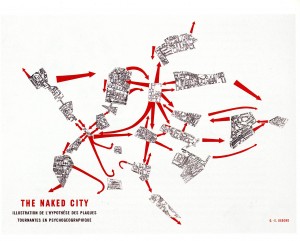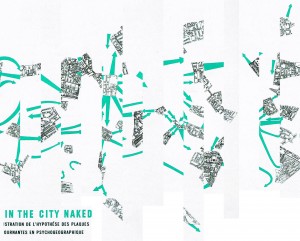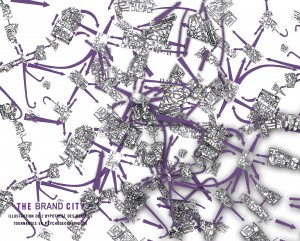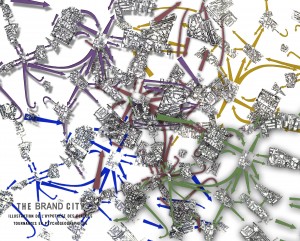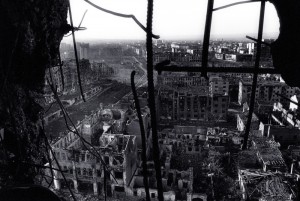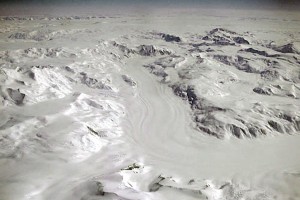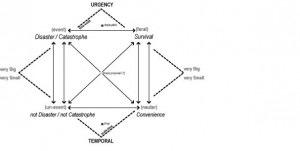The following text is the narrative from my presentation:
My thesis started with an interest in Antarctica andChernobyl. Expanding these territories further, with an interest in “charged landscapes” I started sorting through different typologies of zone. The idea of zone is interesting upon further investigation in relationship to the thesis theme of disaster/catastrophe and its aftermath, because such as the Korean Demilitarized Zone, or the Cyprus Green Line, or The Zone of Alienation of Chernobyl, each of these were caused by a disaster of war, or accidents involving intense infiltration of radiation into a landscape. Other types, and I have them listed here, of extraterritoriality, a special economic zone, or being an involuntary park, a term coined by Bruce Sterling, exist parallel to the disaster, but then release or spawn a new logic, or a zone as a void. In the case of the Green belt of Europe the manifested iron curtain, separating once the USSR from the rest of Europe, or the DMZ or Chernobyl, have created a landscape devoid of human life, are uninhabited, so nature takes over, and animal species and generations thrive there, or endangered species are allow to live in the quarantined off zone in peace.
The intersection of Tarkovsky’s film the Stalker, where adventurers with the guidance of stalkers seek out the “zone”, — it is the same condition here. The zone is parallel to our world, created out of a destructive force, but spawns out a new logic, that exists almost as a void against its container, or its reflexive quarantine.
Extraterritoriality is marked by a state of being exempt from the jurisdiction of law by way of status or treaty. Examples are Antarctica, would probably be different if there were known resources there, the moon, outer space, and the United Nations.
Special Economic Zones are endowed with a policy framework designed for free market, free trade and free open access, set apart from a field of more difficult, unfriendly to the market alternatives. A well known example is of course Shenzhen China, opposite of Hong Kong across the river and the rest are listed here. In addition, Broadband networks connect parallel virtual and real realms, and the category is also listed here. The world has become a Photoshop smash-up of images…
In Keller Easterling’s TED talk, the action is the form, she states that “some of the most radical changes to the globalizing world are being made by contagious spatial forms.” The cross section of dynamic current events leaves an aftermath of charged landscapes, the economic crisis and government failures across the globe, the constant fear and risk of terrorism, and the risk of social unrest and protest, and the ubiquitous computing and broadband networks — these are the tipping points. The thesis proposal is the investigation into the typology of an embassy, an extraterritorial zone, without all of the perks, and poses to re-invent it, considering as diplomacy is between two people and with the embassy the exchange of territory with the condition of trust…can we rethink this? The scaling “embassy” to powers of ten, (reference to Charles and Ray Eames and their film, “Powers of Ten”) mentions a person’s use of cell phones, ubiquitous computing to communicate. Is that a scale of embassy we can begin to work here? So the effect of broadband networks on the typology, but then also resent events in the middle east in September, roughly from the 12 to the 23rd, were protests focused towards United states embassies and those of Canada, France and Germany, and the subsequent decision to close down and remove personnel from the US embassy from Kuala Lumpur, Jakarta, Sana’a, Cairo, Benghazi, which of course was the focal point, Damascus, Tripoli and Tunis. In world that is no longer strictly red communist and blue capitalism since the fall of the Berlinwall and the USSR, and most of the Middle East /North Africa reforming and restructuring into what is yet to be known, how is diplomacy and the embassy situated? (In these red, blue, purple, and white zones…) Is it even between nations? The values of modernism from the 50s, of glass, transparency and openness, democracy, typically the way the United States put out its values, was perhaps never really the true, or is ever more difficult with the threat of terrorism. As an aside the U.S. Embassy in London, recently completed was designed with an beautiful glass façade with these intricate glass modules. But in the design actually forbids WiFi to invade it for security purposes.
The proposal of the un-embassy is in this aftermath zone, and how it attempts to exist parallel to it, but spawn its own logics. The un-embassy, short for the United Nations embassy, is understood at first of being within the United Nations apparatus, existing at first to assist in capital cities of countries that currently do not have an extensive, but rather a limited embassy structure, having less than 25 consulates or embassies, representing other nations within its borders. The un-embassy much the same program as a traditional embassy but the idea is when ambassadors from countries want to discuss the issues, and there is not representative embassy within a country the un-embassy allows for that platform, it is the any country any ambassador embassy, to assemble and essentially is a satellite of the United Nations itself.
Current embassy guidelines enforce a 100 foot minimum distance set back from the street, becomes impossible, when set in a capital cities historic center, the most desired places for countries to put their embassies. Further away from the historic center of the city. High perimeter walls and fences that are difficult to climb, are required protecting the compound, anti-ram barriers, and blast resistant construction techniques. If imagined to go on forever, the embassy is removed from outside then outside of the host territory entirely or at least having to exist within the wall itself, as in the case of the 750 billion dollars embassy in Iraq, in the green zone, which essentially is its own state, self-sufficient. (I do not discredit the fact that it is in a war zone.) The unembassy is a generic in this field of prescriptions.
The un-embassy would allow for an ambassador’s arrival and personal office work space, along with dealing with visa and passport issues, of anyone in the “host” country that is a foreigner. In addition to places of asylum, inspired by Julian Assange, public art works, a hotel residence…etc. The first site of the un-embassy is Gibraltar, a tiny sliver of land below the tip of Spain. It is a member of the European Union and its position close to North Africa. It has its own airport. Only one consulate is located here, the Thai consulate. Being small real estate, embassies are not desired here since they would take up too much land. The un–embassy being released in Gibraltar, depending on its usefulness could spread to other places across near landscapes to cites without a substantial embassy infrastructure. Namely::Yerevan,Armenia, Baku Azerbaijan, Minsk Belarus, Pristina, Kosovo, (that is tricky one…) Sana’a Yemen,Casablanca, Morocco etc. It does not attempt to usurp the existing , intense, pervasive, heavy, expensive, embassy infrastructure in place, but to allow developing nations a platform for dialogue that is more accessible than the UN. (Although in the future it can…) In addition, the idea of an automous zone for the un-embassy could fair well in scenarios where two countries or parties do not have diplomatic relations, but would desire to meet in a third type of zone, the un-embassy.
Essentially, it is an effort to re-brand what an embassy does in the 21st century. Maybe it also becomes an “app”, working on multiple scales that are in face local but based through remote connection. On the periphery it deals with ideas of surface, and infinite interiors which I personally like a lot. It also can serve as an international distribution point for supply of goods in catastrophic events / disasters.
As an aside, this extra paraphernalia (the karst landscape of the Dead Sea) is about another site option…that I entertained for far too long…
Also, I recall the Venice Biennale 2008 theme: “Architecture without Buildings” and in 2010, “People Meet in Architecture” and I think both are relevant here…
